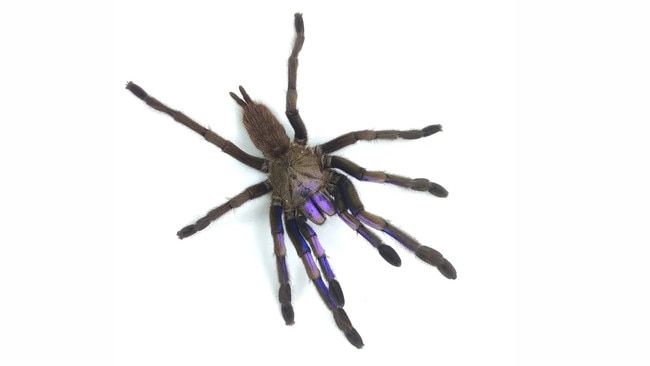New blue tarantula species discovered in Thailand
A new, bright blue tarantula species has just been identified. And, weirdly, it was discovered by a Thai YouTube star.
Animals
Don't miss out on the headlines from Animals. Followed categories will be added to My News.
A dazzling electric blue tarantula has been discovered in Thailand, with researchers describing the newly identified species as “mesmerising”.
The huge creepy crawly was discovered by a group of Thai researchers — including one YouTube star — during an expedition to Phang-Nga in southern Thailand, where they were researching the diversity and distribution of tarantulas in the country.
The newly identified blue species was found living in a mangrove forest.
“(We found) a new species of tarantula that exhibits a mesmerising blue-violet hue, reminiscent of electric blue sparks,” Narin Chomphuphuang, a researcher at Khon Kaen University’s Department of Entomology and Plant Pathology, told CNN.
Curiously, the species had previously been spotted in the catalogues of pet tarantula sellers, but it wasn’t until the species was observed in nature that it could be declared new to science. Several shops claim to be selling them, for up to hundreds of dollars.

Why is the tarantula blue?
A study detailing the exciting discovery of the tarantula was published in ZooKeys last week.
“Blue is one of the rarest colours to appear in nature, which makes blue colouration in animals particularly fascinating,” Dr Chomphuphuang said.
“To appear blue, an object needs to absorb very small amounts of energy while reflecting high-energy blue light,” which is challenging, he explained.
This spider, however, is blue not due to its pigmentation but because of the arrangement of “biological photonic nanostructures”.
That means the electric blue colouring comes not from the presence of blue pigmentation, but rather the “unique structure of their hair, which incorporates nanostructures that manipulate light to create this striking blue appearance,” Dr Chomphuphuang said.
According to the study, the spider’s distinctive colouring comes from two types of hairs, “metallic-blue and violet ones”, which cover its legs, pincers and upper shell and give them a beautiful iridescent shine.
Females and young males had more violet-coloured hairs than metallic blue ones on parts of their bodies, the study added.



Thai YouTube star discovers the spider
The team of researchers included Thai wildlife YouTuber JoCho Sippawat, who has 3.26 million YouTube subscribers.
Some of the same team, including Sippawat, discovered another new type of tarantula in Thailand last year. That tarantula lived in the hollowed stems of bamboo plants, which was unusual.
After its discovery, the team auctioned off the right to name the new, blue species. Funds went to the indigenous Lahu people of northern Thailand, of which Sippawat is a part.
Its scientific name — Chilobrachys natanicharum — is derived from the names of two executives from the company that won the bidding.

Characteristics of the blue tarantula
The blue tarantula lives in tree hollows, making it difficult to capture. The researchers climbed trees in the mangrove forest to lure it out, Dr Chomphuphuang said.
“During our expedition, we walked in the evening and at night during low tide, managing to collect only two of them,” he added.
Typically, tarantulas are either land-dwelling or tree-dwelling, but Chilobrachys natanicharum is both.
But, due to the decline of mangrove forests, Dr Chomphuphuang said the species was also very rare.
Get in touch — chloe.whelan@news.com.au
More Coverage
Originally published as New blue tarantula species discovered in Thailand





